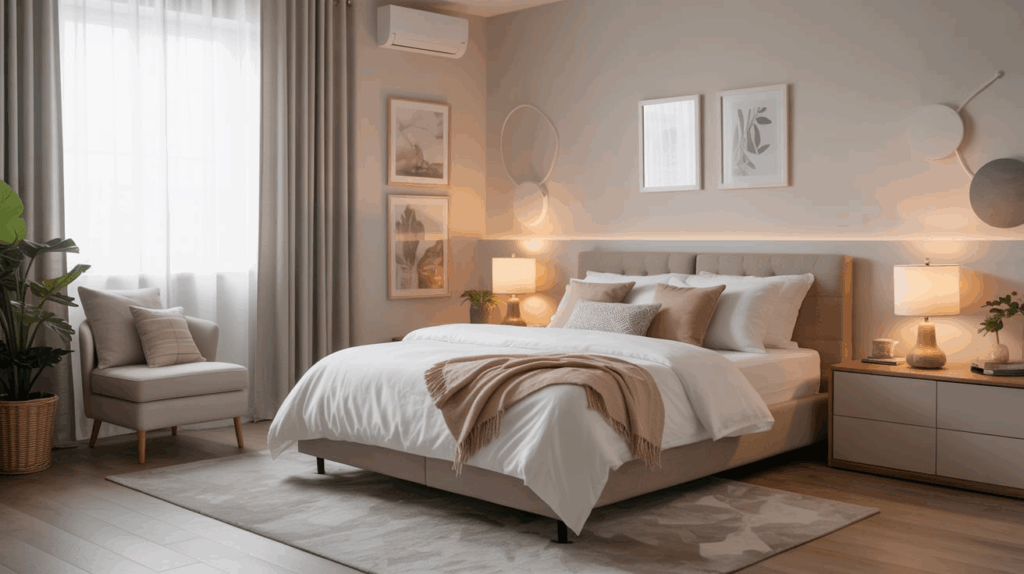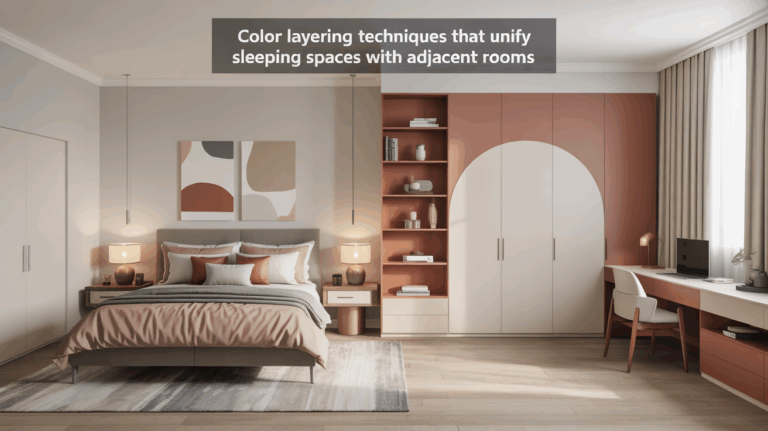Climate and Humidity Considerations for Comfortable, Lasting Bedroom Interiors
I have been, or can be if you click on a link and make a purchase, compensated via a cash payment, gift, or something else of value for writing this post. As an Amazon Associate, I earn from qualifying purchases. Please read my full Affiliate Disclosure for more information.
Climate and humidity shape your sleep comfort and the room’s durability. Aim for 40–60% indoor humidity and steady temps with smart thermostats, layered yet breathable textiles, and breathable bedding. Choose moisture-tolerant finishes, engineered wood, and water‑resistant surfaces. Prioritize cross-ventilation, quiet purifiers, and regular filter changes to keep air fresh. Use dehumidifiers in damp, humid climates and humidifiers when air is dry. With steady humidity, you’ll enjoy calmer nights and lasting materials—and there’s more you can apply as you continue.
Key Takeaways
- Maintain indoor humidity around 40–60% with ventilation, dehumidification, and air exchange to support comfort and mold prevention.
- Use breathable textiles and moisture-tolerant finishes to enhance sleep comfort and surface durability in varying climates.
- Balance temperature with insulation and thermostatic controls for stable, sleep-friendly conditions year-round.
- Implement regular ventilation and air filtration to improve air quality and reduce odors without disrupting sleep.
- Track seasonal humidity shifts to guide sealing, sealing maintenance, and moisture-control strategies for lasting interiors.
Understanding How Climate Affects Sleep Comfort

Ever wonder how the weather in your room quietly shapes how well you sleep? You’ll notice climate nudges your comfort and focus. Understanding climate helps you tune sleep hygiene without overthinking outcomes. Temperature, humidity, and airflow affect how deeply you rest, how quickly you fall asleep, and how morning prompts arrive. Align your bedroom layout to support steadier conditions: breathable fabrics, strategic ventilation, and soft lighting reduce arousal. Simple routines—consistent schedules, layering covers, and a stable thermostat—enhance resilience to noise and external swings. Practical choices create a calmer environment, where mindful climate adjustments meet clear, restful nights.
Assessing Humidity Levels Throughout the Year
You’ll start by noting year‑round humidity trends in your space, spotting how indoor levels mirror or differ from outdoor changes. Seasonal humidity impacts shape comfort needs, from dry winters to muggy summers, guiding your decorating and ventilation choices. With clear comfort targets in mind, you’ll tune your setup to maintain consistent, pleasant humidity year after year.
Year-Round Humidity Trends
Year-round humidity trends reveal how the air in your bedroom shifts with the seasons, guiding you to spot when to tweak ventilation, dehumidification, or moisture-absorbing strategies. You’ll notice humidity fluctuations tied to climate zones, shaping comfort and furniture care across months. Tracking these shifts helps you plan breathable fabrics, discreet dehumidifiers, and appropriate moisture barriers without overreacting to short dips.
- Identify peak and trough months by climate zones
- Choose fabrics and finishes that breathe without staining
- Align ventilation and dehumidification with seasonal patterns
Seasonal Humidity Impacts
Seasonal humidity impacts come into play as the year unfolds, showing how moisture levels rise and fall with the weather outside. You’ll notice seasonal humidity fluctuations when switching from dry winters to humid summers, affecting sleep comfort and fabric longevity. In cooler months, drafts and radiant heat can dry the air, while warmer seasons invite condensation and moisture buildup on walls and windows. To maintain a balanced feel, prioritize consistent indoor humidity control through simple measures: proper ventilation, breathable fabrics, and a lightweight dehumidifier or humidifier as needed. Understanding these shifts helps you preserve comfort and the room’s aesthetic integrity.
Comfort Humidity Targets
What should be your target indoor humidity, and how can you assess it across the year? Aim for about 40–60% depending on season, with tighter goals around 40–50% in winter to avoid condensation and mold growth. Use humidity meters to track daily swings, and note trends after rain or heating changes. Consistency matters more than perfection: adjust ventilation, dehumidification, or humidification as needed, and recheck monthly.
- Track seasonal changes with a simple chart
- Prioritize mold prevention by stabilizing levels
- Calibrate your devices regularly to stay accurate
Breathable Fabrics for Bedding and Upholstery
Breathable fabrics in bedding and upholstery help regulate humidity by allowing air to move and moisture to escape, keeping your space cooler and more comfortable. You’ll feel the difference when choosing fabrics that breathe, so you don’t trap heat or dampness. Look for breathable fabrics that promote airflow and reduce sweat buildup, especially on sheets and pillow covers. Moisture wicking textiles pull moisture away from your skin, supporting a fresher night’s rest. In upholstery, select materials with natural fibers or engineered blends designed for breathability. Practical aesthetics matter: texture, drape, and color should align with your calming, low-humidity aims.
Ventilation Strategies for Fresh Bedroom Air
Good indoor air starts with a simple plan: create a steady flow that replaces stale air without drafts. You’ll optimize comfort by balancing movement, quietness, and efficiency, prioritizing practical ventilation that fits a bedroom’s rhythm. Focus on air circulation patterns that minimize stagnation while preserving warmth. Window placement becomes central: position openings to encourage cross-ventilation without exposing you to chilly drafts. Use zoning inside the room to guide airflow and avoid localized heat buildup. The result is a calmer, fresher space you can trust for restful nights.
- Align window placement with natural currents for continuous air circulation
- Choose discreet vents or operable windows that don’t disrupt sleep
- Favor gradual, balanced exchange over abrupt drafts or noise
Moisture Control Basics: Dehumidifiers and Humidifiers
Humidity can quietly shape how comfy your bedroom feels, so after setting up steady air movement, it’s worth pairing that flow with smart moisture control. You’ll use dehumidifiers to pull excess moisture from the air and humidifiers to add it when humidity drops too low, keeping a stable range for comfort and sleep. Choose models with quiet operation and appropriate capacity for your room size. Regularly monitor humidity levels, seal leaks, and clean filters. Consider air purifier technology in tandem for cleaner air, and coat surfaces with mold resistant coatings to deter growth. Stay practical, aesthetic, and precise in your moisture routine.
Materials That Stand Up to Moisture and Temperature Fluctuations
When you choose moisture-resistant materials, you’ll reduce warping, staining, and odors while keeping your space looking clean and calm. Opt for surfaces that stay stable with temperature changes—think moisture-friendly woods, composites, and sealed textiles that resist swelling. This balance of durability and design sets a foundation for a bedroom that remains comfortable and beautiful, even as humidity shifts.
Moisture-Resistant Materials
Moisture-resistant materials are essential in a bedroom where humidity and temperature swing can take a toll on surfaces. You’ll want choices that stay durable, look refined, and resist moisture without shouting for attention.
- Choose boards and panels with moisture resistance ratings and smooth, wipeable finishes
- Use mold prevention-friendly substrates and proper ventilation to curb dampness
- Apply waterproof coatings or sealants on high-touch areas and exposed edges
In practice, select materials that balance form and function, prioritizing seams, joints, and coatings that deter moisture intrusion. This approach keeps surfaces looking fresh, while supporting long-term comfort and aesthetics.
Temperature-Stable Surfaces
You’ve laid out moisture-smart choices, and now you’ll want surfaces that stay steady as humidity and temperature swing. Temperature-stable surfaces resist warping and staining while keeping color consistent, so your room reads calm and cohesive. Look for materials with good temperature regulation, such as solid wood with stable laminates, stone composites, or ceramic tile backed by solid backing. Prioritize surface insulation to slow heat transfer and reduce hot-cold shocks on touch. Minimize seams and gaps that trap moisture. Select finishes with low water absorption and UV resistance to maintain sheen. With thoughtful choices, you’ll enjoy durable, comfortable, timeless surfaces.
Paints, Finishes, and Wood: Choosing Durable Options
Choosing durable paints, finishes, and woods means balancing performance with feel: you want surfaces that resist humidity, prevent warping, and still look inviting in your bedroom.
- Pick low-VOC paints with proven paint durability and a moisture-tolerant finish to curb humidity issues.
- Choose boards and veneers that showcase natural wood grain while resisting swelling; look for engineered wood or furniture-grade plywood.
- Seal edges and seams well, using water-based sealers that protect without darkening tones.
These choices keep surfaces cohesive, practical, and aesthetically calm, helping you maintain durable beauty without sacrificing comfort.
Thermal Comfort: Balancing Heat and Coolness
Thermal comfort in a bedroom hinges on balancing heat and coolness so the space feels restful year-round. You aim for reliable warmth in winter and cool relief in summer without drastic swings. Achieve this with thoughtful layering: breathable textiles, properly sized windows, and a thermostatic control that matches your routines. Prioritize thermal insulation to reduce heat transfer, keeping rooms even and efficient. This supports energy efficiency, lowering bills and environmental impact. Choose materials with steady performance, like dense insulating curtains and well-sealed enclosures. With balanced atmosphere, you’ll enjoy consistent sleep-friendly temperatures and a calmer, more welcoming retreat.
Odor Management and Air Quality Improvement
Fresh air and a clean scent set the mood for restful sleep, so addressing odor and air quality in a bedroom matters as much as comfort and warmth. You’ll notice clearer air when you reduce moisture, trap odors, and introduce gentle filtration. Practical steps blend form and function without clutter.
- Improve air quality with a quiet air purifier and regular filter changes
- Use odor absorption solutions like activated charcoal or baking soda in discreet containers
- Maintain ventilation by opening windows when possible and managing humidity levels
These habits support calm ambiance, cleaner air, and a refreshed, inviting sleeping environment.
Maintenance and Long-Term Durability of Bedroom Interiors
Maintaining bedroom interiors isn’t just about looks—it’s about durability and daily ease. You’ll protect surfaces by choosing low-wum or low-emission finishes and sealing wood to resist moisture. Prioritize stable humidity with consistent air filtration and routine filter checks, so dust and allergens stay manageable without constant rewipes. Implement natural ventilation where possible, pairing it with seasonal adjustments to prevent condensation and mold risk. Rotate textiles and scale back water exposure in upholstery to sustain textures and color. Schedule quarterly checks on seals, caulking, and seals around windows. Simple maintenance sustains aesthetics, comfort, and long-term durability.
Conclusion
As you design and refresh your bedroom, think climate first: steady humidity, breathable textiles, and clean air all matter. You’ll sleep deeper when textures stay comfortable, temps stay balanced, and odors stay negligible. Use smart ventilation, manage moisture with a quiet dehumidifier or humidifier, and seal drafts. Pick durable paints and woods, paired with easy-care finishes. With thoughtful maintenance, your space remains inviting, soothing, and lasting through seasons.






